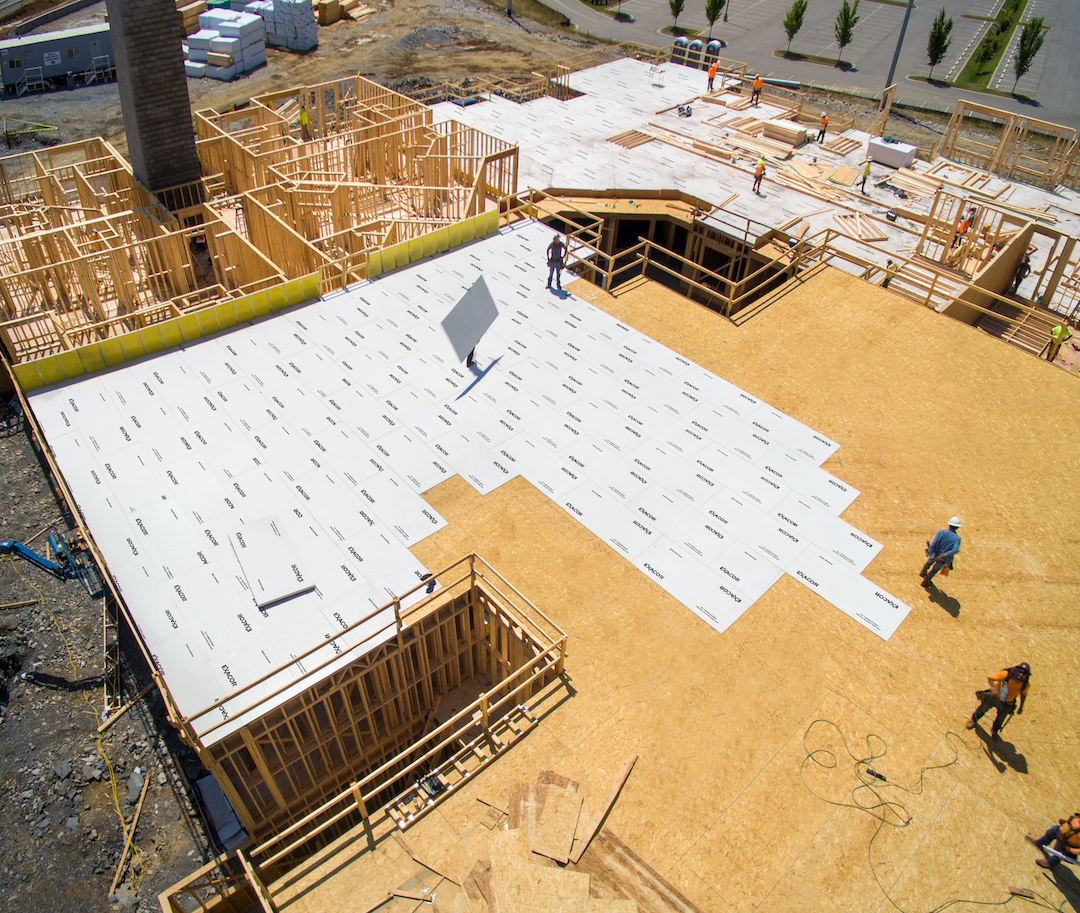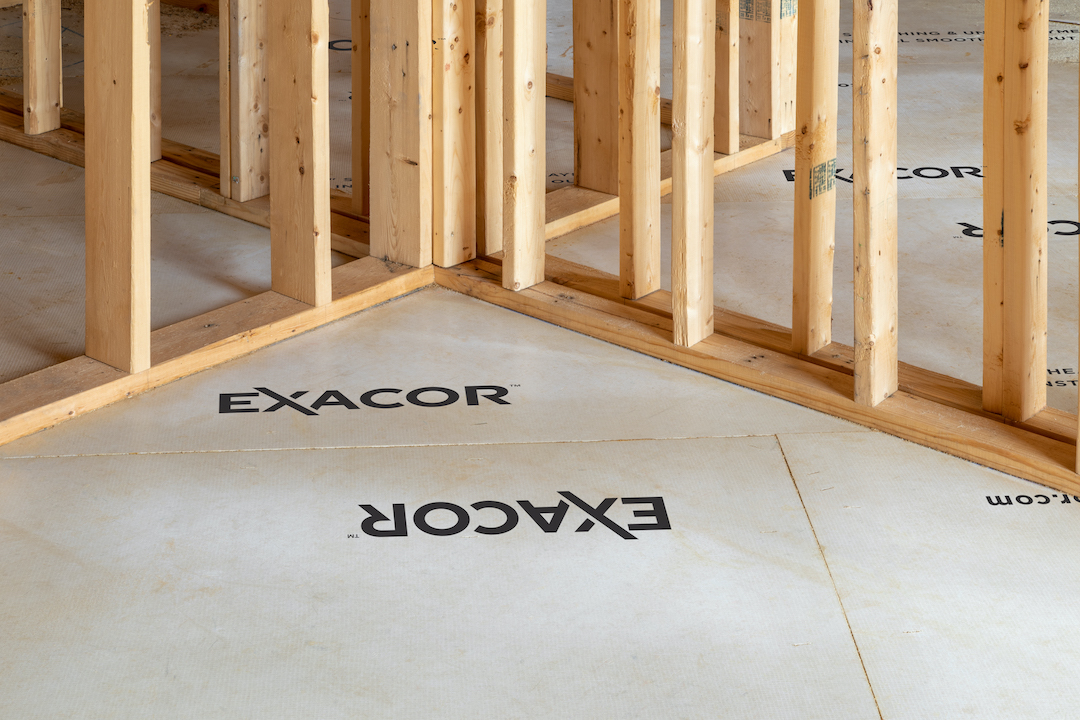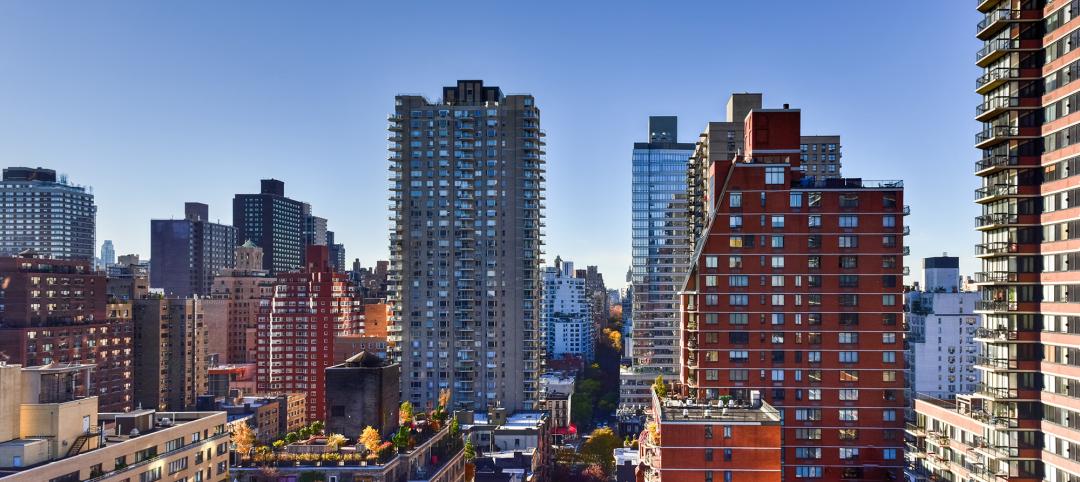According to Christine Williamson, a building scientist and consultant who built her career studying building failures, a single building mistake or installation error in new construction can lead to compounding problems, while a single wise decision, well executed, can lead to disproportionate benefits in building performance. (1)
While building performance in multifamily construction sometimes refers to acoustic performance, other factors such as fire protection are equally important.
To successfully build with these considerations in mind, architects and developers must keep pace with guidelines from code bodies while turning to innovative product solutions to get the job done effectively.
TDK Construction, a development and construction company in Murfreesboro, Tenn., is doing just that with the recent use of EXACOR magnesium oxide (MgO) panels, a decision its team agrees equated to real-time savings in a recent 127-unit luxury apartment community in Goodlettsville, Tenn.

EXACOR MgO subfloor panels being installed by TDK Construction crew at a luxury multifamily project in Goodlettsville, Tenn. Photo: Huber Engineered Woods
‘TIME IS MONEY,’ SAYS CONSTRUCTION SUPERVISOR
Historically, wet-laid gypsum underlayment and a sound mat have been the go-to materials for fire resistance and sound attenuation in floor assemblies of multifamily construction.
The biggest issue with gypsum underlayment has always been the additional time the installation and curing process can add to a construction schedule.
Because builders have to schedule gypsum underlayment subcontractors well in advance, the application cure time adds weeks to the timeline. Many multifamily builders also take issue with the large amount of moisture the liquid-based product adds to the job.
So, when there are time and budget savings to be had with new building technologies, multifamily builders such as TDK Construction are open to change.
“Our construction supply company sales rep had other contractors in the area say they were skeptical, but as we were laying EXACOR underlayment down, they saw how quick the process was. It was faster than laying just traditional subfloor,” said Todd Hardy, supervisor for TDK Construction. “Time is money and if we can save time on one job, let alone all our jobs, that really adds up.”
According to Hardy, the EXACOR underlayment installation took less time than installing gypsum underlayment and eliminated the need for an additional crew to be added to the schedule.
Hardy’s framing crew worked quickly and were already on site to install the EXACOR underlayment over the subfloor they had just completed. He estimates that using EXACOR underlayment saved the company approximately $30,000 in their budget and knocked almost two months off the construction schedule (2). This allowed renters of the luxury apartment complex to start moving in sooner than originally projected.

EXACOR magnesium oxide panels met the UL rating for one-hour fire-rated floor assembly, as well as IBC and IIC sound attenuation ratings. Photo: Huber Engineered Woods
MGO PANELS MEET FIRE AND SOUND-RATING STANDARDS
EXACOR MgO panels can also address two of the biggest concerns in multifamily dwellings: fire resistance and sound attenuation.
When used in specific fire and sound-rated assemblies, EXACOR underlayment panels can meet the fire rating (3), sound rating (3), and dimensional stability requirements of most multifamily and light commercial job sites.
EXACOR panels are also fire resistant (3) due to a magnesium oxide formula and provide strength and stability due to the integrated mesh core for structure (4).
“The fire marshal’s main concern is always meeting the UL rating — it needs to maintain a one-hour fire-rated floor assembly,” Hardy said. “When we put the subfloor in and then the EXACOR underlayment, the UL rating was achieved.”(4)
As for sound attenuation. while some background noise in multifamily living is common, excessive noise can lead to high tenant turnover.
Developers and architects must design to minimum thresholds for airborne sound transfer set by the International Building Code (IBC) to meet certain Sound Transmission Class (STC) ratings. The IBC also determines structure-borne transfer ratings for Impact Insulation Class (IIC), or how a floor/ceiling assembly transmits the sound of an impact.
STC ratings cover airborne noises like talking, music, or appliances in neighboring apartments. IIC ratings account for impact noises like footfall, dropped items, and furniture movement.
“With construction projects like ours — a three-story building — you want to make sure you alleviate all the sound from above, and that is always one of the architect’s biggest challenges,” Hardy said. “With the gypsum underlayment assembly we’ve used in the past, we had to add a sound mat between the gypsum underlayment and the finished flooring. This was eliminated with the EXACOR underlayment assembly.”
EXACOR panels also provide added sound attenuation benefits. When used as a part of a STC/IIC-tested floor/ceiling assembly, EXACOR underlayment panels installed over plywood or OSB subfloors can help builders achieve or exceed code minimums for dwelling separations.
EXACOR underlayment assemblies also may eliminate the need for a sound mat, depending on the architect’s overall flooring assembly design.
JUST ONE CREW FOR UNDERLAYMENT AND FRAMING
With fire and sound codes satisfied, what resonated most with Hardy and builder/owner TDK Construction was the time savings associated with using EXACOR MgO panels. Unlike gypsum underlayment, which is poured after exterior and interior walls are in place, EXACOR panels can be installed by framers as part of the framing package, with walls then framed on top of the EXACOR panels. That means one crew can install both the underlayment and framing, using their existing tools, equating to time and budget savings.
Hardy also noticed that eliminating gypsum underlayment meant they did not have to make any adjustments to door headers on the second and third floors since there wasn’t any variance in the thickness of EXACOR underlayment.
“Our framers could prefab everything, they don’t have to worry about the first, second, third floor being different,” Hardy said. “With gypsum underlayment, there were always unknowns, things you wouldn’t discover until you’re deep into the construction process.”
An added bonus for crews? No mess. EXACOR can eliminate cleaning headaches associated with gypsum underlayment, such as spills, difficulty around tub framing, and threshold unevenness.
“Not to mention the mess that the wet-laid gypsum crew can make — it gets everywhere, on the walls, on the tubs, all over the place — and we spend a lot of time just cleaning it up,” Hardy said.
AT TDK, IT’S ‘ALL ABOUT GETTING THE JOB DONE’
As multifamily construction continues to evolve, products that upgrade and innovate the process will be needed. Using innovative solutions such as EXACOR MgO panels is one way to address those needs, accelerating the ease of the construction process and providing a glimpse of what better building looks like.
TDK Construction will be one of those better builders leading the way in multifamily dwellings made with EXACOR MgO panels.
“We’ll use this for everything going forward,” said Hardy. “At TDK Construction, everything we build, we own. Our owner and developer are all about getting the job done, and they were super happy with the results.”
To learn more about EXACOR products, visit EXACOR products.
NOTES AND REFERENCES
- Williamson, Christine. “Acoustic Control in Multi-Family Construction,” Home Building Crossroads, February 2021.
- Pricing will vary by region. Check with your local channel partner on pricing and availability.
- EXACOR panels may be used in specific published fire-resistant-rated assemblies as tested in accordance with ASTM E119 / ANSI UL 263. Follow published fire-resistance rated assembly requirements and consult local building codes and designer of record for fire-resistant design requirements.
- This project was designed in accordance with UL L528. Click here to see the assembly specifications. Sound and fire ratings vary by assembly. Refer to the EXACOR Sound & Fire Assemblies Handbook at exacor.com/acoustics.
Related Stories
Adaptive Reuse | Aug 14, 2024
Adaptive reuse revives a former warehouse in St. Louis
The Victor, as the building is now called, has nearly 400 residential apartments.
MFPRO+ News | Aug 14, 2024
Report outlines how Atlanta can collaborate with private sector to spur more housing construction
A report by an Urban Land Institute’s Advisory Services panel, commissioned by the city’s housing authority, Atlanta Housing (AH), offered ways the city could collaborate with developers to spur more housing construction.
MFPRO+ Research | Aug 9, 2024
Apartment completions to surpass 500,000 for first time ever
While the U.S. continues to maintain a steady pace of delivering new apartments, this year will be one for the record books.
MFPRO+ Research | Aug 6, 2024
Matrix multifamily report for July shows ‘hopeful signs’
The multifamily market is showing strength in many ways, according to the July 2024 Matrix Multifamily National Report by Yardi Matrix.
MFPRO+ News | Aug 1, 2024
Canada tries massive incentive program to spur new multifamily housing construction
Canada has taken the unprecedented step of offering billions in infrastructure funds to communities in return for eliminating single-family housing zoning.
Student Housing | Jul 31, 2024
The University of Michigan addresses a decades-long student housing shortage with a new housing-dining facility
The University of Michigan has faced a decades-long shortage of on-campus student housing. In a couple of years, the situation should significantly improve with the addition of a new residential community on Central Campus in Ann Arbor, Mich. The University of Michigan has engaged American Campus Communities in a public-private partnership to lead the development of the environmentally sustainable living-learning student community.
MFPRO+ New Projects | Jul 31, 2024
Shipping containers converted into attractive, affordable multifamily housing in L.A.
In the Watts neighborhood in Los Angeles, a new affordable multifamily housing project using shipping containers resulted in 24 micro-units for formerly unhoused residents. The containers were acquired from a nearby port and converted into housing units at a factory.
Smart Buildings | Jul 25, 2024
A Swiss startup devises an intelligent photovoltaic façade that tracks and moves with the sun
Zurich Soft Robotics says Solskin can reduce building energy consumption by up to 80% while producing up to 40% more electricity than comparable façade systems.
Great Solutions | Jul 23, 2024
41 Great Solutions for architects, engineers, and contractors
AI ChatBots, ambient computing, floating MRIs, low-carbon cement, sunshine on demand, next-generation top-down construction. These and 35 other innovations make up our 2024 Great Solutions Report, which highlights fresh ideas and innovations from leading architecture, engineering, and construction firms.
MFPRO+ News | Jul 22, 2024
Miami luxury condominium tower will have more than 50,000 sf of amenities
Continuum Club & Residences, a new 32-story luxury condominium tower in the coveted North Bay Village of Miami will feature more than 50,000 sf of indoor and outdoor amenities. The program includes a waterfront restaurant, dining terraces with resident privileges, and a private dining room outdoor pavilion.

















